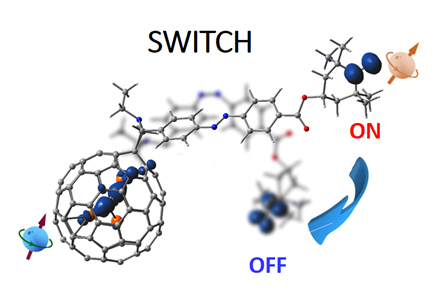| [1] |
Popov, A. A.; Yang, S.-F.; Dunsch, L. Chem. Rev. 2013, 113, 5989.
|
| [2] |
Niu, C.; Wang, G.-W. Chin. J. Org. Chem. 2020, 40, 3633. (in Chinese)
doi: 10.6023/cjoc202006081
|
|
( 牛闯, 王官武, 有机化学, 2020, 40, 3633.)
|
| [3] |
Dong, W.; Nie, M.-S.; Lian, Y.-F. Acta Chim. Sinica 2017, 75, 453. (in Chinese)
doi: 10.6023/A17030090
|
|
( 董薇, 聂梦思, 廉永福, 化学学报, 2017, 75, 453.)
|
| [4] |
Ma, Y.-H.; Wang, T.-S.; Wu, J.-Y.; Feng, Y.-Q.; Jiang, L.; Shu, C.-Y.; Wang, C.-R. Chem. Commun. 2012, 48, 11570.
doi: 10.1039/c2cc36435b
|
| [5] |
Meng, H.-B.; Zhao, C.; Nie, M.-Z.; Wang, C.-R.; Wang, T.-S. Nanoscale 2018, 10, 18119.
doi: 10.1039/C8NR06045B
|
| [6] |
Feng, Y.-Q.; Wang, T.-S.; Li, Y.-J.; Li, J.; Wu, J.-Y.; Wu, B.; Jiang, L.; Wang, C.-R. J. Am. Chem. Soc. 2015, 137, 15055.
doi: 10.1021/jacs.5b10796
|
| [7] |
Yang, S.-F.; Wei, T.; Jin, F. Chem. Soc. Rev. 2017, 46, 5005.
doi: 10.1039/C6CS00498A
|
| [8] |
Choi, Y.-J.; Kim, J.-T.; Yoon, W.-J.; Kang, D.-G.; Park, M.; Kim, D.-Y.; Lee, M.-H.; Ahn, S.-k.; Jeong, K.-U. ACS Macro Lett. 2018, 7, 576.
doi: 10.1021/acsmacrolett.8b00167
|
| [9] |
Dattler, D.; Fuks, G.; Heiser, J.; Moulin, E.; Perrot, A.; Yao, X.; Giuseppone, N. Chem. Rev. 2020, 120, 310.
doi: 10.1021/acs.chemrev.9b00288
|
| [10] |
Qian, H.-Y.; He, P.; Zhang, L.; Chen, K.; Xu, B.-B.; Lin, S.-L. Chin. J. Org. Chem. 2021, 41, 2891. (in Chinese)
doi: 10.6023/cjoc202102047
|
|
( 钱鸿宇, 何品, 张璐, 陈珂, 徐彬彬, 林绍梁, 有机化学, 2021, 41, 2891.)
|
| [11] |
Zhai, Y.-L.; Xu, W.-J.; Meng, X.-R.; Hou, H.-W. Acta Chim. Sinica 2020, 78, 256. (in Chinese)
doi: 10.6023/A19120427
|
|
( 翟亚丽, 许文娟, 孟祥茹, 侯红卫, 化学学报, 2020, 78, 256.)
|
| [12] |
Bandara, H. M. D.; Burdette, S. C. Chem. Soc. Rev. 2012, 41, 1809.
doi: 10.1039/C1CS15179G
|
| [13] |
Tavadze, P.; Avendaño Franco, G.; Ren, P.-J.; Wen, X.-D.; Li, Y.-W.; Lewis, J. P. J. Am. Chem. Soc. 2018, 140, 285.
doi: 10.1021/jacs.7b10030
|
| [14] |
Cheng, S.-C.; Wang, C.-H.; Lin, Y.-C.; Tsuchido, Y.; Suzaki, Y.; Sei, Y.; Kuo, T.-S.; Horie, M. ACS Appl. Mater. Interfaces 2020, 12, 50002.
doi: 10.1021/acsami.0c15171
|
| [15] |
Ichimura, K.; Oh, S.-K.; Nakagawa, M. Science 2000, 288, 1624.
doi: 10.1126/science.288.5471.1624
|
| [16] |
Shirai, Y.; Sasaki, T.; Guerrero, J. M.; Yu, B.-C.; Hodge, P.; Tour, J. M. ACS Nano 2008, 2, 97.
doi: 10.1021/nn700294m
|
| [17] |
Lee, T.-H.; Han, G.-Y.; Yi, M.-B.; Kim, H.-J.; Lee, J.-H.; Kim, S. ACS Appl. Mater. Interfaces 2021, 13, 43364.
doi: 10.1021/acsami.1c11680
|
| [18] |
Yan, Y.; Wang, X.; Chen, J. I. L.; Ginger, D. S. J. Am. Chem. Soc. 2013, 135, 8382.
doi: 10.1021/ja403249u
|
| [19] |
Kroto, H. W.; Heath, J. R.; O'Brien, S. C.; Curl, R. F.; Smalley, R. E. Nature 1985, 318, 162.
doi: 10.1038/318162a0
|
| [20] |
Nakatsuji, S. I.; Fujino, M.; Hasegawa, S.; Akutsu, H.; Yamada, J.-I.; Gurman, V. S.; Vorobiev, A. K. J. Org. Chem. 2007, 72, 2021.
doi: 10.1021/jo062266f
|
| [21] |
Nachtigall, O.; Lomoth, R.; Dahlstrand, C.; Lundstedt, A.; Gogoll, A.; Webb, M. J.; Grennberg, H. Eur. J. Org. Chem. 2014, 2014, 966.
doi: 10.1002/ejoc.v2014.5
|
| [22] |
Kato, T.; Suzuki, S.; Kikuchi, K.; Achiba, Y. J. Phys. Chem. 1993, 97, 13425.
doi: 10.1021/j100153a001
|
| [23] |
Wang, T.-S.; Wang, C.-R. Acc. Chem. Res. 2014, 47, 450.
doi: 10.1021/ar400156z
|
| [24] |
Wang, T.-S.; Wu, J.-Y.; Xu, W.; Xiang, J.-F.; Lu, X.; Li, B.; Jiang, L.; Shu, C.-Y.; Wang, C.-R. Angew. Chem., Int. Ed. 2010, 49, 1786.
doi: 10.1002/anie.v49:10
|
| [25] |
Li, Y.; Lei, X.; Lawler, R. G.; Murata, Y.; Komatsu, K.; Turro, N. J. J. Phys. Chem. Lett. 2011, 2, 741.
doi: 10.1021/jz200192s
|
| [26] |
Wu, B.; Wang, T.-S.; Feng, Y.-Q.; Zhang, Z.-X.; Jiang, L.; Wang, C.-R. Nat. Commun. 2015, 6, 6468.
doi: 10.1038/ncomms7468
|
 ), 王冲a,b, 李宝林a,c, 王春儒a,b
), 王冲a,b, 李宝林a,c, 王春儒a,b
 ), Chong Wanga,b, Baolin Lia,c, Chunru Wanga,b
), Chong Wanga,b, Baolin Lia,c, Chunru Wanga,b
